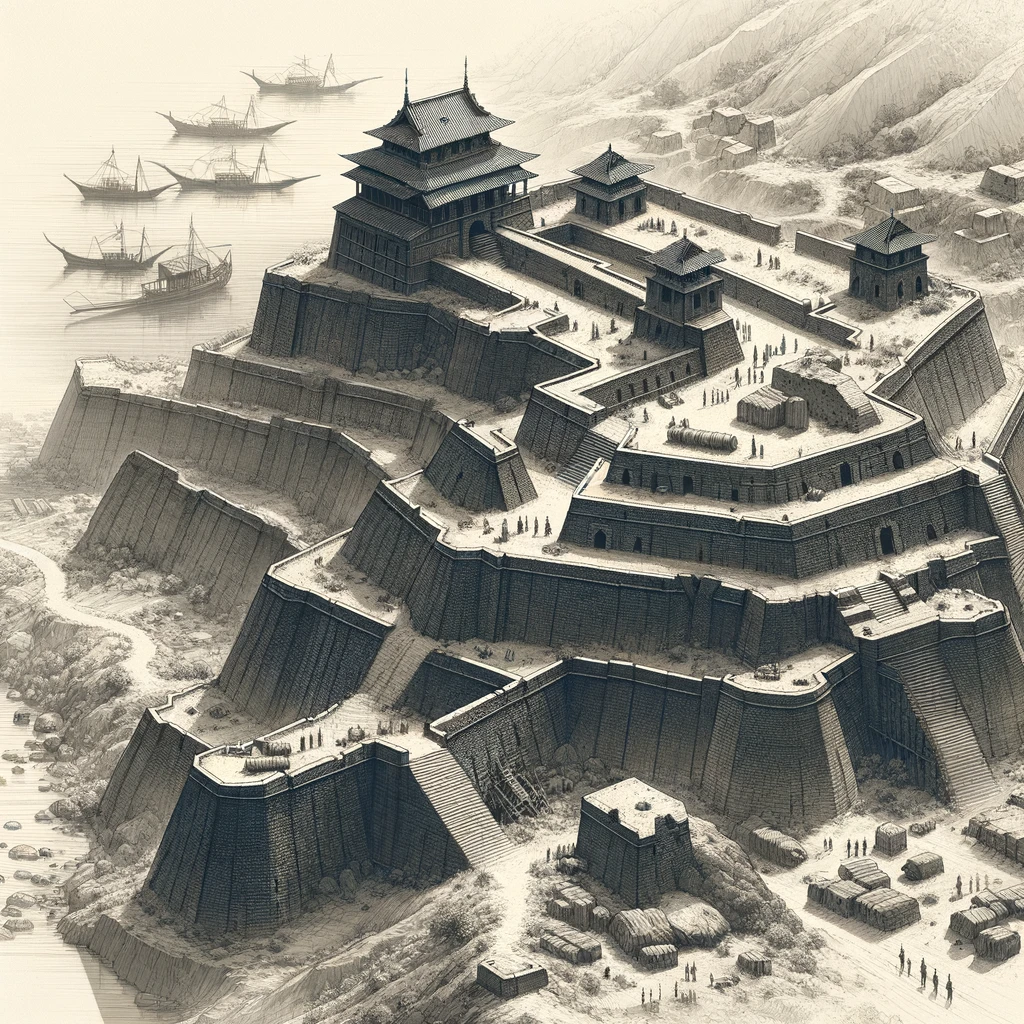Construction of Nedumkotta
Table of Contents
ToggleEndavour For Nedumkotta
The construction of Nedumkotta, known as the Travancore Lines, stands as a pivotal moment in Indian history. Initiated in May 1740, this extensive fortification was a strategic masterpiece by the rulers of Travancore, designed to protect their realm from the expanding threats of the Mysore Kingdom. This essay explores the multifaceted significance of Nedumkotta in Indian history, delving into its architectural innovations, strategic importance, and lasting impact on the cultural and political fabric of the region. By examining the fortification’s construction, its role in regional stability, and its enduring legacy, we gain insights into the complex interplay of military strategy and cultural identity in historical statecraft.
Nedumkotta Construction: Historical Background
Ascension and Ambitions of Tipu Sultan
In the late 18th century, Tipu Sultan emerged as a formidable ruler after inheriting the kingdom of Mysore following his father Hyder Ali’s death. Known for his sharp military strategies and robust administrative reforms, Tipu Sultan rapidly expanded his domain, striking fear into the hearts of neighboring states. His aggressive policies and expansionist ambitions were not just limited to territorial conquest but also involved the spread of his religious and ideological beliefs, often leading to significant strife and tension in the region.
Tipu Sultan’s Military Campaigns and Religious Policies

Tipu Sultan’s military campaigns were marked by his victories and the subsequent harsh treatment of defeated foes, particularly in terms of religious oppression. Historical accounts suggest that his campaigns in regions such as Malabar involved forced conversions, destruction of temples, and imposition of Islamic practices, which incited fear and resistance among the Hindu populations of those areas. These actions contributed to a complex legacy, combining administrative efficiency and religious intolerance.
Historical Quote
To substantiate the claims about Tipu Sultan’s impact, noted historian Dr. A. Sreedhara Menon states in his work, ‘A Survey of Kerala History’, that ‘Tipu’s invasion of Malabar had been marked by widespread destruction and unprecedented atrocities. Temples and shrines were systematically destroyed and the resident populations faced forced conversions.’ This account highlights the aggressive nature of his campaigns and their cultural impact on the regions he conquered.
Threat Posed to Travancore
The princely state of Travancore, under the wise leadership of Marthanda Varma and later his successors, became a focal point of Tipu Sultan’s expansionist gaze. Situated at the southern tip of the Indian subcontinent, Travancore was not only affluent due to its spice trade and strategic maritime routes but also symbolically significant for maintaining Hindu cultural and religious traditions amidst the Islamic conquests advancing from the north. The threat of invasion by Tipu Sultan carried with it not only the fear of loss of territory but also the potential upheaval of the region’s religious and cultural fabric.
Economic Prosperity and Maritime Significance
Travancore’s wealth was legendary, drawing from its abundant natural resources and lucrative trade in spices, ivory, and peacock feathers. Its ports buzzed with international trade, connecting it to global maritime routes. This economic prosperity made Travancore a gem worth coveting for any ambitious ruler like Tipu Sultan.
Crucial for Regional Power Balance
Beyond its wealth, Travancore’s strategic location acted as a buffer state, absorbing and thus diminishing the impacts of northern aggression on the southern peninsular regions. Its defense was paramount not only for its own preservation but also for maintaining the stability and power dynamics of the entire southern Indian region. The defense of Travancore was thus crucial in ensuring that the southern peninsula did not fall entirely under the sway of Tipu Sultan’s dominion, which might have altered the cultural and political landscapes drastically.
In summary, the rise of Tipu Sultan presented a multifaceted threat to Travancore, combining military might with religious and ideological impositions. The state’s response, encapsulated in the construction of Nedumkotta, was not merely a military strategy but also a stand to preserve its very identity and heritage against overwhelming odds.
Construction of Nedumkotta
Planning and Design
The construction of Nedumkotta, initiated in the early 18th century, was a monumental endeavor, underpinned by meticulous planning and strategic foresight. The fortification extended over 48 kilometers, strategically harnessing the natural topography of the region, including hills, rivers, and dense forests, to create an imposing barrier against potential invaders. This incorporation of natural terrain was not only practical for defense but also economical in terms of construction, as it reduced the need for man-made materials where nature provided natural obstacles.
Unique Architectural and Engineering Features of Nedumkotta
Integration with Natural Landscape
Nedumkotta’s design exemplifies a harmonious blend of natural geography and man-made structures. The fortification took advantage of the Vembanad Lake on the west and the dense forests along the Western Ghats on the east, creating a formidable natural barrier that was difficult for enemy forces to navigate.
Trenches and Bastions
The architecture of Nedumkotta was distinguished by its extensive network of deep trenches and high bastions. These trenches were strategically dug to serve both as the first line of defense and as a hindrance to the advance of cavalry and artillery. The bastions, placed at regular intervals, were fortified with cannons and provided elevated platforms for better surveillance and firepower.
Adaptation of Indian and European Techniques
Architecturally, Nedumkotta was a fusion of traditional Indian military construction methods and European fortification techniques. This blend was evident in the angular bastions, which were inspired by European star forts, designed to deflect cannon shots and provide sweeping fields of fire. Indian elements were prominent in the use of local materials like laterite stones and the construction of covered pathways that protected soldiers from the harsh tropical sun and enemy fire.
Role of Local Rulers and Engineers in Nedumkotta
Leadership and Vision
The visionary behind this massive project was Maharaja Marthanda Varma of Travancore, who initially conceived the idea of such a grand fortification to protect his kingdom. His successors, particularly Dharma Raja Kartika Thirunal Rama Varma, continued his efforts, recognizing the strategic importance of securing their borders against the burgeoning threat from Mysore.
Collaboration and Manpower
The construction of Nedumkotta was a significant logistical challenge that required the collaboration of numerous local chieftains, engineers, and architects. Thousands of laborers from various parts of Travancore and neighboring regions were mobilized. The project not only required physical labor but also the intellectual input of experienced military architects who could adapt complex military engineering theories into practical, executable designs.
Economic and Social Impact
The construction of Nedumkotta also had a profound socio-economic impact on the region. It provided employment to thousands, stimulated local economies, and increased the strategic importance of the region. The fortifications boosted the morale of the Travancore army and instilled a sense of security among the populace, fostering a period of relative peace and prosperity that allowed arts and culture to flourish under the protective shadow of Nedumkotta.
In essence, the construction of Nedumkotta stands as a testament to the architectural and engineering prowess of the era, the strategic acumen of Travancore’s rulers, and the resilience of its people. This grand fortification not only served its immediate military purpose but also became a symbol of the region’s ability to integrate advanced defensive technologies with its unique geographical and cultural characteristics.
Historical Quote
A personal account from the era, recorded in the diaries of Anantha Krishna Iyer, a local scholar in Travancore, offers a poignant perspective: ‘The days were clouded with the fear of Tipu Sultan’s advancing forces. Our markets were less crowded, and the nights were spent in prayers for safety. The construction of Nedumkotta brought a glimmer of hope to our people, a testament to our ruler’s resolve to protect us from the encroaching danger.’ This narrative vividly captures the atmosphere of uncertainty and the relief brought by the construction of Nedumkotta.
Impact and Legacy of Nedumkotta
Defensive Successes
The construction of Nedumkotta, with its strategic foresight and robust design, played a pivotal role in safeguarding Travancore during tumultuous times. The fortification’s ability to harness natural terrain features along with man-made defensive structures like deep trenches and imposing bastions, provided a formidable barrier against the advancing forces of Mysore. Throughout the period of Tipu Sultan’s campaigns, Nedumkotta proved its worth by significantly delaying, and in many instances outright deterring, the Sultan’s formidable military. This not only protected the physical boundaries of Travancore but also preserved its sovereignty, preventing the kingdom from becoming another conquest in Tipu Sultan’s expansionist endeavors.
Cultural and Political Significance
Beyond the tangible military advantages it provided, Nedumkotta had a profound impact on the cultural and political landscape of Travancore. The sense of security that the fortifications offered allowed the kingdom to thrive in an era marked by frequent regional conflicts. This stability was a catalyst for cultural development, promoting the arts, literature, and traditional practices that defined the unique heritage of the region. Politically, Nedumkotta symbolized the strength and foresight of the Travancore rulers, enhancing their stature among their subjects and their negotiating power with foreign entities. It became a symbol of the technological and administrative prowess of Travancore, showcasing the kingdom’s capability to undertake and complete massive engineering projects that were both advanced and strategic.
Preservation and Historical Importance
Today, the remnants of Nedumkotta serve as a historical monument, bearing witness to the ingenuity and strategic acumen of past generations. These ruins, scattered across the region, are not merely relics of stone and earth but symbols of a resilient culture that withstood the tides of aggression through prudent and effective defensive architecture. They remind us of the crucial role that environmental adaptation and technological innovation played in historical military strategies.
Moreover, Nedumkotta’s historical importance extends to its role in the collective memory of the region as a line of defense that stood firm against formidable odds. As a testament to the enduring human spirit, these remnants inspire current and future generations to appreciate and preserve the rich history of their land. They are a focal point for historians and tourists alike, who seek to understand the complexities of regional dynamics in historical India and the lengths to which societies will go to protect their homeland.
In summary, the legacy of Nedumkotta transcends its original military purpose, embodying the cultural resilience, political wisdom, and historical consciousness of Travancore. Its story is a compelling chapter in the annals of Indian fortifications, celebrated for its strategic successes and revered for its profound impact on the region’s identity and heritage.
Reflections and Summarizing
The construction of Nedumkotta in May 1740 was more than a military project; it was an emblematic act of sovereignty and cultural safeguarding in Indian history. As a formidable defense against Mysore’s expansionist threats, Nedumkotta not only protected the borders of Travancore but also preserved its unique cultural and political identity amidst the shifts in Indian history. Today, as a historical and architectural relic in Kerala, Nedumkotta stands as a symbol of the strategic brilliance and enduring spirit of Indian resilience, continuing to attract scholarly attention and inspiring those interested in the profound impacts of military architecture on Indian history and society.
Featiure Image: The image showcases a detailed digital representation of an 18th-century fort, designed with a blend of traditional Indian military architecture and European fortification techniques. It features deep trenches and high bastions, with angular shapes reminiscent of European star forts. The fort is constructed using local materials, such as laterite stones, and is strategically situated among natural elements like hills and rivers, enhancing its defensive capabilities. The grayscale tone adds a classic and historical feel to the depiction. (Click here to view the image)
